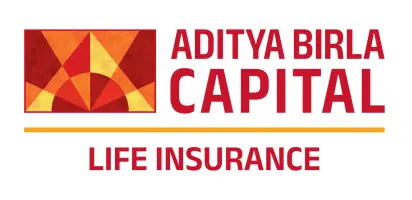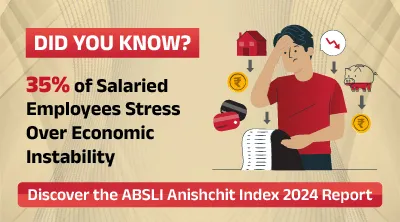** Sec 10(10D) benefit is available subject to fulfilment of conditions specified therein
* Tax benefits are subject to changes in tax laws. Kindly consult your financial advisor for more details.
#Provided all due premiums are paid
^ As per annual audited figures submitted to IRDAI for the period FY 24 – 25 for individual death claims paid.
¹ LI Age 21, Male, Salaried, Non Smoker, Option 1: Level Cover, PPT: Regular Pay, SA: ₹ 1 Cr., PT: 10 years, Premium paying term: 10 years, Death Benefit Payout as Lumpsum. Annual Premium: ₹ 5584/- ( which is ₹ 465/month). On death, 1 Cr SA is paid and the policy terminates.
² Provided 0 year deferment & Annually in Advance payout frequency is chosen at the time of inception of the policy. Annually in Advance payout frequency is only available in "Annual" premium payment mode.
³ Scenario: ABSLI Akshaya Plan, Age 35, Healthy Male, Premium Payment Term: 6 years, Policy Term: 25 years, Benefit Option: Long Term Income, Premium Rs.1lakh p.a. (Rs.100,000X6), Cash Bonus Payout Frequency: Annually in Arrears, Sum Assured: Rs 710,000. Assumed @8% p.a., Cash Bonus (if declared) p.a. = Rs 23,004, Total Cash Bonus (if declared) (A)= Rs 5,75,100, Terminal Bonus (If declared) + Sum Assured (B) = Rs 8,73,300, Total Benefit (A+B) = Rs 14,48,400. Assumed @4% p.a., Cash Bonus (if declared) p.a. = Rs 8,520, Total Cash Bonus (if declared) (A)= Rs 2,13,000, Terminal Bonus (If declared) + Sum Assured (B) = Rs 7,95,200, Total Benefit (A+B) = Rs 10,08,200.
ABSLI Accidental Death And Disability Rider - This rider is underwritten by Aditya Birla Sun Life Insurance Company Limited (ABSLI). UIN: 109B018V03
ABSLI Critical Illness rider. This rider is underwritten by Aditya Birla Sun Life Insurance Company Limited (ABSLI). UIN: 109B019V03
ABSLI Surgical Care Rider. This rider is underwritten by Aditya Birla Sun Life Insurance Company Limited (ABSLI). UIN: 109B015V03
ABSLI Hospital Care Rider. This rider is underwritten by Aditya Birla Sun Life Insurance Company Limited (ABSLI). UIN: 109B016V03
ABSLI Waiver Of Premium Rider. This rider is underwritten by Aditya Birla Sun Life Insurance Company Limited (ABSLI).UIN: 109A039V01
ABSLI Nishchit Aayush Plan. This is a non-linked non-participating individual savings life insurance plan.UIN: 109N137V12
ABSLI Super Term Plan - This Policy is underwritten by Aditya Birla Sun Life Insurance Company Limited (ABSLI). This is a non-linked non-participating individual pure risk premium life insurance plan; (UIN: 109N153V01) upon Policyholder’s selection of Plan Option 3 (Level Cover with Return of Premium) this product shall be a non-linked non-participating individual savings life insurance plan.
ABSLI Akshaya plan is a non-linked participating individual savings life insurance plan (UIN: 109N136V04)
In the Unit Linked Policy, the investment risk in the investment portfolio is borne by the Policyholder.
Linked Life insurance products are different from the traditional life insurance products and are subject to the risk factors.
Linked Insurance Products do not offer any liquidity during the first five years of the contract.
The policyholder will not be able to withdraw/surrender the monies invested in Linked Insurance Products completely or partially till the end of the fifth year from inception. Please know the associated risks and the applicable charges, from your Insurance agent or the Intermediary or policy document. The premium paid in unit linked life insurance policies are subject to investment risk associated with equity markets and the unit price of the units may go up or down based on the performance of fund and factors influencing the capital market and the policyholder is responsible for his/her decisions. Tax benefits* may be available as per prevailing tax laws. For more details on risk factors, terms and conditions please read sales brochure carefully before concluding the sale.
For further details regarding the above-mentioned rider, please refer to the respective rider brochure(s) available on our website.
The endorsement of ABSLI Super Term Plan by the celebrity is intended solely for promotional purposes. The views expressed by the celebrity do not constitute financial, legal, or insurance advice. The endorsement does not imply any guarantee or assurance about the performance or suitability of the insurance product. Customers are encouraged to carefully review all policy documents and consult with a licensed insurance advisor or financial professional before making any insurance purchase decision. The terms and conditions of the policy shall prevail over any promotional content.
Honesty is the best policy
Applicants should ensure that insurance details in the application form is filled by oneself with “ Utmost good faith”.
Be honest & truthful about your medical history, health conditions, or any other complications.
Also, let the insurer know about any habits like use of alcohol, tobacco or any narcotics/ psychotropic substances in the present or past, to ease the process of Policy issuance and claim assessment process.
ADV/6/25-26/515










